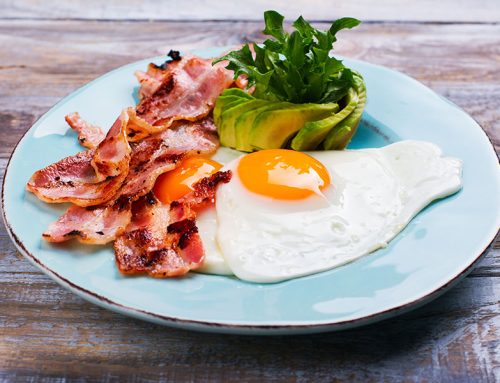According to the Center For Disease Control, only 10% of Americans get the minimum recommended daily fruit and vegetable intake.
That’s an unfortunate statistic considering that eating more vegetables and fruits every day is one of the best ways to get healthier and lose weight without much effort. Heck, we’re not even telling you to count calories, track macros or stop eating favorite foods, we’re just suggesting to eat more veggies.
If you formed just two simple habits – eat a lean protein with every meal and eat a fruit, vegetable or both with every meal – you would get leaner and healthier, almost automatically.
I get it though. Some people struggle with increasing their vegetable intake simply because they say they don’t enjoy eating them. It’s important to choose foods you enjoy. That’s one way you customize a meal plan so it’s easier to follow.
Yet vegetables and fruit are so valuable for both health and fat loss, eating them is also important, whether you enjoy them or not. Fortunately, you’re about to learn ways to make it much more enjoyable to eat more vegetables, even delicious, and how you can also disguise them or sneak more of them into your favorite recipes.
Fruit is an easier choice for many people due to the natural sweetness (I call fruit “nature’s candy”). If you must, start out improving the nutritional quality of your diet by eating more fruits.
But also make it a goal to eat more vegetables too, and especially with different ways of cooking and preparing them. If you take an interest in cooking and are open to trying different recipes, you may discover you start looking forward to veggies. Since I started getting serious about home cooking in the last couple years, I love veggies more than ever.
Another reason many people still don’t eat enough fruits and vegetables is not that they dislike all of them, but they don’t know how to incorporate more of them into their diet. They’re not home cooks (yet), let alone professional chefs, and no one ever explained to them how to eat more vegetables and make them enjoyable.
Are you among the many who know they need to eat more fruits and veggies (especially veggies), but aren’t doing it yet? If so, I’m sure you don’t want to be nagged more. But I’m also guessing you would be open to new ideas for getting more fruits and veggies into your daily meal plan in ways you could enjoy them.
That’s what you’ll learn in today’s post. You’ll see an amazing list of 30 great ideas below. Most of them are vegetable ideas, but I included a handful of ways to boost your fruit intake as well. I guarantee you’ll find some you’ll love.
1. Eat more vegetables with your starchy carb-dominant meals, including pasta
One reason people fall short on vegetables, which is also a reason they aren’t losing fat, is because they’re eating too many starchy carbs and grains relative to their fibrous carbs.
Many people enjoy a large bowl of pasta, but the pasta dish has no veggies, other than maybe a chunky tomato sauce. If you add vegetables to the dish, it’s still a delicious pasta meal, but since there’s less pasta and more veggies, you cut the calorie density and increase the nutrient density. This works great for cold pasta salads as well.
I even use this trick in my Thanksgiving day stuffing – I load that up with mushrooms and celery and drop the amount of bread way down. You could describe this as diluting the starchy carbs- or sneaking in more veggies into carb foods you already like. This also works great with rice, beans, quinoa, noodles and even potatoes.
Sun dried tomato linguini with ground turkey contains 3X as much vegetables as pasta (members)
Black eyed peas and rice with tenderloin contains more veggies than black eyed peas (members)
Quinoa tuna salad – has more veggies than quinoa (members)
Lean chicken stroganoff – twice as many vegetables as noodles (members)
2. Add veggies to pasta sauces
While it’s ideal to mix large amounts of veggies right into the pasta, another option is to add some diced veggies to the pasta sauce. You could try chunky diced tomatoes, onions, mushrooms or bell peppers.
3. Try zucchini noodles (zoodles) instead of pasta
Zucchini is delicious steamed or roasted, especially when nicely seasoned, but many people don’t realize you can turn zucchini into noodles, also known as zoodles. You can buy a spiralizer and make your own from whole zucchini or you can find them at your local grocery store.
Using zoodles in place of regular pasta saves a huge number of calories while making vegetables the primary ingredient in the meal. Don’t stop with just zoodles either. In my zoodle pesto with ground turkey recipe I include cherry tomatoes, mushrooms and onions for a total of four veggies in one meal!
Low calorie pesto zoodles with lean ground turkey (members)
4. Make a stir fry with more vegetables than rice or noodles
The same calorie-density reduction idea I use with pasta can be applied to stir fry. Most people stir fry their vegetables and then serve a small portion of them on top of giant pile of rice. With one simple tweak, you can increase your daily vegetable intake and decrease your calorie intake at the same time while staying full: Instead of following traditional recipes, increase the vegetable portion and decrease the rice portion.
Muscle making teriyaki stir fri – twice as many veggies than rice by volume
5. Load up Mexican meals with veggies, while reducing the calorie-dense ingredients
If you’re making Mexican, add more veggies again and reduce the starchy carbs and fats. Load up on lean protein (lean beef or chicken) mixed with extra salsa, lettuce, tomatoes, peppers and onions or other veggies when you make fajitas and reduce the amount of tortilla or rice. At the same time ditch the chips and eliminate or at least reduce the sour cream and guac. If you use cheese, use nonfat or low-fat cheese.
Fancy seasoned sautéed fajita vegetables
6. Add lots of vegetables into soups and stews
I have a favorite beef stew recipe that I make with the traditional ingredients including potatoes, carrots, celery and onions. The difference is, once again I lower calorie density by reducing the amount of potatoes (starchy carbs) while increasing the amount of vegetables (fibrous carbs). Meanwhile, the amount of starchy carb, in this case potatoes, is much lower than in classic stew recipes. The result is lower calories and more nutritious veggies with the great same taste.
Feed the Muscle beef stew – has more veggies than potatoes
7. Eat eggs often, even daily, and load them with vegetables (eat veggies for breakfast!)
Almost every day, my staple breakfast is eggs that are loaded up with vegetables. Egg scrambles, omelets and frittatas work with a wide variety of vegetables. One of my favorite scrambles is with onions, bell peppers, mushrooms and spinach (with nonfat cheese to boost the protein even more). But you don’t have to stop there – you can add almost any veggie into your eggs. When you load your eggs with veggies, it creates a huge mound of food that’s incredibly filling even without a starchy carb like oats, whole grain bread, or pancakes.
Fat burning veggie frittata for one
8. Keep raw vegetables in the refrigerator, ready to eat
If you’ve ever felt a sudden hankering for a snack, you may have found that it’s possible to “surf the urge” until it passes, but it’s not always easy to do nothing and ride the wave of a craving. At times like these, what’s in the house and easily accessible may be the deciding factor in what you choose to eat.
Ultra-processed snack foods like chips or cookies could easily wipe out a day’s calorie deficit. But if you have cut and prepared raw veggies ready, you could enjoy a large portion and still end up in a significant deficit for the day. \
Bonus tip: If you keep light dressings or dips on hand, it can be an enjoyable treat. Low or no-calorie ranch or honey mustard dressings are great as veggie dips.
What Ultra-Processed Food Does To Your Body
9. Eat huge salads with leafy greens, a variety of colorful veggies and a tasty dressing
At least once a day, I eat a huge salad with a protein (chicken breast, turkey breast, tuna or salmon). It’s never just lettuce. I throw in lots of veggies – whatever is in my fridge. Usually that’s spinach, tomatoes, cabbage, cucumbers, carrots, bell peppers, celery, broccoli, or cauliflower. I don’t even need a starchy carb with it to feel full even though the calories are low. Sometimes I don’t even try to count the calories or measure the veggies, but I know it’s not many because nearly all the veggies are the fibrous kind. A tasty dressing makes the salads enjoyable. If I’m cutting, it’s zero calorie dressings like Walden Farms or Maple Grove Farms.
10. Add more veggies to tuna salad
Don’t just mix tuna fish with mayonnaise, load that up with veggies including celery, carrots, bell peppers, pickles and so on. It’s not a lot of veggies, but every little bit helps, and it tastes great. Use reduced calorie mayonnaise to reduce the calorie density even more.
11. Add vegetables to sandwiches
Lettuce is often used in sandwiches, so are tomatoes and pickles. That’s great, but not a full veggie serving, so also consider a stack of spinach, shredded carrots, sliced cucumber or sprouts. And also make sure the bread is whole grain and swap higher calorie large bread slices for lower calorie types. You could even have a small salad or raw veggies on the side.
12. Make wraps out of vegetables
Don’t just add more veggies inside your sandwiches, instead of a tortilla or wrap, use lettuce or collard greens. You’ll not only be adding more greens, you’ll be cutting carb calories too.
13. Add vegetables to burgers
In addition to using the leanest meat available, don’t load burgers with bacon and full fat cheese. Load them with veggies. Lettuce, onion and tomato are great, but I’m not just talking about what goes on top. You can mix chopped vegetables right into your ground meat. Onions, mushrooms, bell peppers, celery, or carrots are all great options. This not only sneaks more veggies into your meal, it makes burgers made with extra lean meat much more moist.
Mega protein TNT (Tasty Nutritious Turkey) Burgers (members)
14. Add vegetables to meatballs
Meatballs are such an under-rated protein source! One of my favorite lean beef meatball recipes is made with a big serving of onion, celery and carrots. My favorite ground turkey meatball recipe is the one loaded with zucchini. It is delicious, and just like burgers, it keeps them super moist even when you’re using the leanest meat.
Bodybuilder baked meatballs – with celery, carrots and onions (members)
15. Add veggies to meatloaf
It’s easy enough to serve a side of veggies with your meatloaf – I usually do (sauteed mushrooms are great). But why not also add some right into the loaf? One of my ground turkey meatloaf recipes includes a full cup each of onions and carrots, plus fresh basil, parsley and garlic. My beef meatloaf often includes generous amounts of onions, mushrooms or both. You could even sneak spinach into your meatloaf! Why not? You can sneak spinach into anything.
Clean and lean turkey meatloaf – with carrots, onions and fresh herbs (members)
16. Use cauliflower as a potato substitute
Cauliflower is not just great steamed, roasted or raw, it’s a fantastic way to decrease starchy carbs and increase veggies. Mashed cauliflower is also a mashed potato substitute. You can replace the potatoes with cauliflower completely or use half the usual amount of potatoes and make the other half cauliflower.
Garlic parmesan mashed cauliflower – “faux mashed potatoes” (members)
17. Use cauliflower as a rice substitute
Riced cauliflower is also a great rice substitute. Plus, riced cauliflower is widely available in regular grocery stores, so you don’t have to rice it yourself if you don’t want to.
18. Add vegetables to baked goods, bread or desserts
Yes, you can even add vegetables to baked goods. Try zucchini bread or zucchini muffins! How about spinach in cheddar muffins? Sweet potatoes are considered a starchy carb, though they are a vegetable. There are so many delicious goodies you can bake with sweet potatoes, even brownies (and my Burn the Fat Feed the Muscle sweet potato brownies are the best in the world!) Don’t forget about pumpkin either – you can use it in pancakes, bread and all kinds of tasty desserts that people love in the fall.
The best sweet potato protein brownies in the world
19. Use salsa generously as a convenient topping, sauce or seasoning
Salsa is mainly tomatoes, onions, pepper and chiles, but the sky is the limit with ingredients. Salsa is sometimes even made with mango (more fruit) or corn (more veggies). For lazy eggs, sometimes I simply top them with salsa, then grab a piece of whole fruit on the side so I have fruit and at least a small amount of veggies in the same meal.
20. Make vegetables insanely delicious by roasting them
Even people who normally don’t like to eat more vegetables often love them when they’re roasted. That’s because roasting veggies brings out their natural sweetness, and gives them a caramelization or browning and depth of flavor they don’t get from steaming. (You definitely don’t get that from microwaving frozen veggies in a bag, which must be the blandest way to make veggies). Even brussels sprouts, which are often named among the top five least favorite veggies are delicious when roasted. Use only a small amount of oil, then add salt, pepper and your favorite herbs then roast in the oven.
21. Grill your vegetables
You can make veggies taste great by grilling them too. If asparagus doesn’t appeal to you, my guess is you’ve never tried asparagus seasoned and grilled. Even with nothing but olive oil, salt, and pepper, it’s delicious!
22. Try sauteed, seasoned vegetables
Another way to cook your veggies is to sauté them on the stovetop. Just a bit of olive oil and your favorite seasonings make them taste great. The possibilities are endless. Three of my favorites include sauteed mushrooms with garlic, fresh parsley, salt and pepper, zucchini with curry spice, salt and pepper, and garlic sautéed spinach and mushrooms.
Garlic sautéed spinach and mushrooms (members)
23. Season your steamed vegetables
Many people think of steamed veggies as the plain kind, where oil is sometimes not even used (or just a drizzle). However, salt pepper and the herb or spice of your choice alone can add just enough flavor to make them enjoyable and virtually no extra calories are added. Another bonus is that like sautéing, it only takes minutes. Other ideas: lemon juice or lemon zest, garlic, vinegar, soy sauce or sesame oil.
24. Add all kinds of veggies and greens to smoothies
Increase your veggie intake by adding all kinds of veggies to smoothies. Have a green smoothie and literally drink your vegetables. Add protein powder if you like. (Lean protein plus veggies is the ultimate fat loss combination you know).
25. Make protein smoothies with whole fruit (not fruit juice)
Instead of using fruit juice, which is calorie dense and lacks fiber, make smoothies with whole fruit. If you want to boost protein and add thickness, use non fat Greek yogurt and or whey or casein powder.
26. Keep one or more bowls of fruit stocked up and in sight
What’s out of sight is out of mind. High calorie, processed trigger foods should be kept out of the house or at least out of view. Foods you want to form a habit of eating often should be left in plain view where you can’t miss them. Always keep one or more bowls of fruit on the kitchen countertop. For fruits that need refrigeration, keep them in a bowl or container and ready to eat right in the front of the refrigerator at eye level.
27. Make protein ice cream with whole frozen fruit
Want to increase your fruit intake and protein intake with enjoying guilt-free ice cream? Add 150g of frozen strawberries, 31g scoop protein powder (casein is ideal because it’s thicker, but other kinds like whey will work), ½ cup skim milk and 1-2 packets of sweetener to a mixing bowl. Blend (a hand /immersion blender works fine). Eat immediately as soft serve or put in freezer at least an hour to eat like scoopable ice cream.
You can do this with many fruits – berries, bananas, peaches, pineapple and more. I have over a half a dozen frozen fruit protein ice cream recipes in our collection at Burn the Fat Inner Circle (located in our recipe department and meal planner software).
3 ingredient muscle-building strawberry protein ice cream
Decadent dark chocolate peanut butter protein ice cream (members)
28. Freeze grapes for a cold snack
Frozen grapes couldn’t make a quicker and easier snack, especially refreshing on a hot day. It’s like eating little grape popsicles.
29. Top pancakes with fruit instead of regular syrup
Syrup is delicious but it’s also liquid sugar. Instead of regular syrup, try topping your pancakes with fruit. If you really want the syrup, use the sugar-free variety (such as Walden farms), but keep the whole fruit too!
30. Add fruit into Greek yogurt
Always add fruit into your Greek yogurt! My favorite is blueberries, but almost any fruit goes great in Greek yogurt.
Enjoy!
If you want to eat more vegetables and fruits, you can now see that it’s not as hard as you think. And when you try some of these suggestions above, veggies taste better than you think! Enjoy!
Tom Venuto,
Author of Burn the Fat, Feed the Muscle – The Bible Of Fat Loss
Founder, Burn the Fat Inner Circle
Nearly 300 recipes are available for Burn the Fat Inner Circle members. Not a member? Join us! CLICK HERE

Tom Venuto is a natural bodybuilding and fat loss expert. He is also a recipe creator specializing in fat-burning, muscle-building cooking. Tom is a former competitive bodybuilder and today works as a full-time fitness coach, writer, blogger, and author. In his spare time, he is an avid outdoor enthusiast and backpacker. His book, Burn The Fat, Feed The Muscle is an international bestseller, first as an ebook and now as a hardcover and audiobook. The Body Fat Solution, Tom’s book about emotional eating and long-term weight maintenance, was an Oprah Magazine and Men’s Fitness Magazine pick. Tom is also the founder of Burn The Fat Inner Circle – a fitness support community with over 55,000 members worldwide since 2006. Click here to learn more about Burn the fat Inner Circle








Leave A Comment